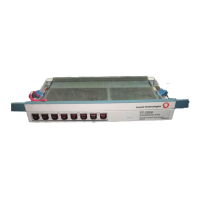About This Document
xxxvi Issue 8.0 July 2002
Classification of Lasers
Manufacturers of lasers and laser products in the United States are regulated by
the Food and Drug Administration's Center for Devices and Radiological Health
(FDA/CDRH) under 21 CFR 1040. These regulations require manufacturers to
certify each laser or laser product as belonging to one of the major Classes I, II,
IIa, IIIa, IIIb, or IV. Lasers are classified according to the accessible emission limits
and their potential for causing injury. Lightwave systems are generally classified
as Class I, because, under normal operating conditions, all energized laser
transmitting circuit packs are terminated on optical fibers which enclose the laser
energy with the fiber sheath forming a protective housing. Also, covers are in
place over the circuit pack shelves.
Lightwave Safety Precautions
Under normal operating conditions, the FT-2000 OC-48 Lightwave System is
totally enclosed and presents no risk of eye injury. It is a Class I system under the
FDA/CDRH scheme.
The lightguide cables that interconnect various components of a lightwave system
can disconnect or break and may expose people to lightwave emission. Also,
certain measures and maintenance procedures may expose the technician to
emission from the semiconductor laser during installation and servicing. Unlike
more familiar laser devices, such as solid-state and gas lasers, the emission
pattern of a semiconductor laser results in a highly divergent beam. In a divergent
beam, the irradiance (power density) decreases rapidly with distance. The greater
the distance, the less energy will enter the eye and the less potential risk for eye
injury.
Inadvertently viewing an unterminated fiber or damaged fiber with the unaided
eye at distances greater than 5 to 6 inches normally will not cause eye injury
provided the power in the fiber is less than a few milliwatts at the shorter
wavelengths and higher at the longer wavelengths. However, damage may occur
if an optical instrument such as a microscope, magnifying glass, or eye loupe is
used to stare at the energized fiber end.
!
WARNING:
Use of controls or adjustments or performance of procedures other than
those specified herein may result in hazardous laser radiation exposure.

